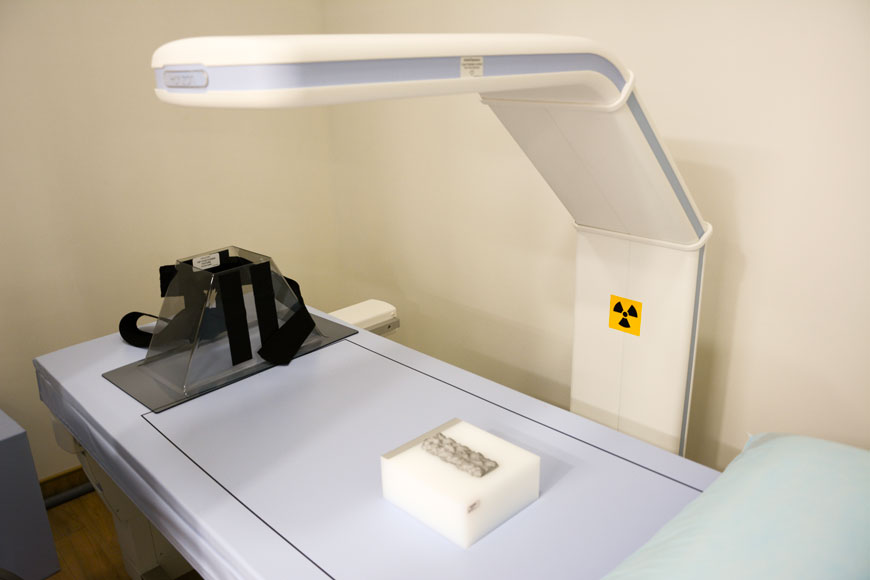What is a Bone Density Scan?
Bone density scanning, also called dual-energy x-ray absorptiometry or bone densitometry (BMD), is a special form of X-ray technology that is used to determine bone strength and measure bone loss.
The BMD machine employs low-dose X-rays with two distinct energy peaks through the bones being examined. One peak is absorbed mainly by soft tissue and the other by bone. The soft tissue amount is subtracted from the total and what remains is the bone mineral density.
A BMD scan is usually performed on the lower spine and hips. A special computer is used to measure the density of the bone in these spots and from there determine if osteoporosis is present.

What is a BMD for?
- BMD is most often used to diagnose osteoporosis, a condition that often affects women after menopause but may also be found in men and rarely in children. Osteoporosis involves a gradual loss of calcium, as well as structural changes, causing the bones to become thinner, more fragile, and more likely to break.
- BMD is also used to monitor the effects of treatment for osteoporosis and other conditions that cause bone loss.
- The BMD test can also be used to assess an individual’s risk for developing fractures. The risk of fracture is affected by age, body weight, history of prior fracture, family history of osteoporotic fractures and life style factors such as cigarette smoking and excessive alcohol consumption. These factors are taken into consideration when deciding if a patient needs therapy.
Bone Density Testing is Recommended if You:
- are post-menopausal and not taking estrogen or who are tall (over 5 feet 7 inches) or thin (less than 125 pounds)
- have a personal or maternal history of hip fracture or smoking
- are a man with clinical conditions associated with bone loss
- use medications that are known to cause bone loss, including corticosteroids, anti-seizure medications, certain barbiturates, or high-dose thyroid replacement drugs
- have Type 1 (formerly called Juvenile or Insulin-Dependent) Diabetes, liver or kidney disease, or a family history of Osteoporosis.
- have high bone turnover, which shows up in the form of excessive collagen in urine samples
- have a (para)thyroid condition, such a hyperthyroidism and hyperparathyroidism
- have experienced a fracture after only mild trauma
- have had X-Ray Evidence of Vertebral Fracture or other signs of Osteoporosis.

How should I Prepare for a BMD?
- On the day of the exam you may eat normally. You should not take calcium supplements for at least 24 hours before your exam.
- You should wear loose, comfortable clothing, avoiding garments that have zippers, belts or buttons made of metal. Objects such as keys or wallets that would be in the area being scanned should be removed.
- You may be asked to remove some or all of your clothes and to wear a gown during the exam. You may also be asked to remove jewelry and any metal objects or clothing that might interfere with the x-ray images.
- Inform your doctor if you recently had a barium examination or have been injected with a contrast material for a computed tomography (CT) scan or radioisotope scan. You may have to wait 10 to 14 days before undergoing a BMD test.
- Women should always inform their doctor and radiologist if there is any possibility that they are pregnant. Many imaging tests are not performed during pregnancy so as not to expose the fetus to radiation.
How is a BMD performed?
This examination is usually done on an outpatient basis. To measure bone density in the hip and spine, you will be asked to lie on a padded table and the legs may be supported on a padded box to flatten the pelvis and lower (lumbar) spine. To assess the hip, the foot is placed in a brace that rotates the hip inward. In both cases, the detector is slowly passed over the area, generating images on a computer monitor.
You should hold very still and may be asked to keep from breathing for a few seconds while the X-ray picture is taken to reduce the possibility of a blurred image.
The BMD bone density test is usually completed within 15 minutes, depending on the equipment used and the parts of the body being examined.



